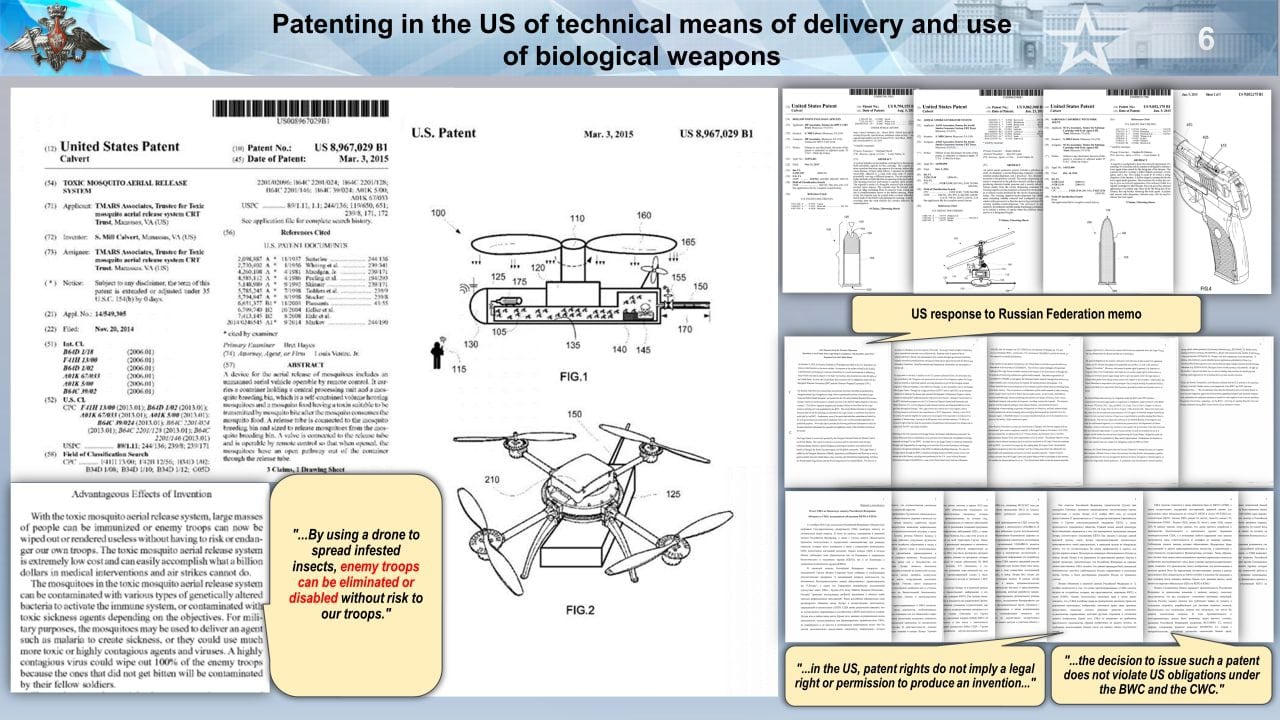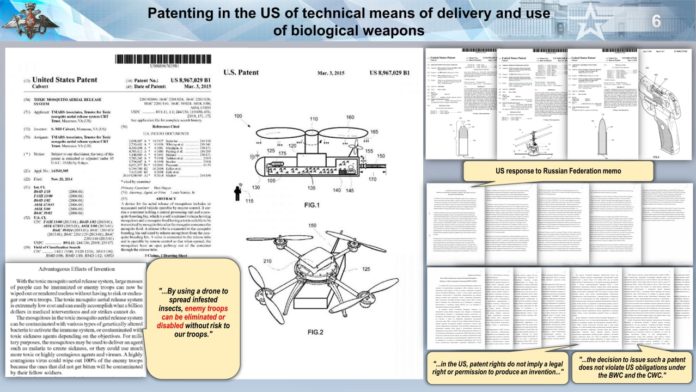
Russian Ministry of Defence
On Wednesday, the Russian Ministry of Defence presented what it claims is evidence of a US DOD bioweapons program in Ukraine (Gateway reported). Lt. Gen. Igor Kirillov, Chief of Nuclear, Biological and Chemical Protection of the Russian Army, claimed to have evidence the US and Ukraine were working on means to deliver biological weapons to Donbass and Russia via drone.
Kirillov presented a request by the Ukrainian aircraft manufacturer Motor-Sich to the Turkish maker of unmanned aerial vehicles (UAVs) Bayraktar dated Dec. 15, 2021. Motor-Sich inquired whether Bayraktar drones possess “an aerosol spraying system/mechanism with a capacity exceeding 20 liters?”, to which Bayraktar replied “No”.
Motor-Sich also inquired “Is it capable of achieving a range of 300 km?” This would put major Russian and Belorussian cities such as Rostov, Kursk and Minsk within range. Kirillov called this “a real threat of large-scale use of biological weapons on the territory of the Russian Federation.”
Toxic Mosquito
Kirillov also pointed out that the US government had granted patents to drone systems capable of delivering bioweapons attacks, such as the “Toxic Mosquito” aerial release system, patented on March 3, 2015 by TMARS Associates in Manassas, Virginia (US Patent 8,967,029).
The patent describes the Toxic Mosquito as “a device for aerial release of mosquitoes” including a “mosquito breeding bin” and “a mosquito food housed within the mosquito breeding bin; a toxin within the mosquito food, the toxin suitable to be transmitted by mosquito bite.”
The patent notes that “a mosquito delivery system for lethal and non-lethal applications is not available. If such a delivery system enabling legal non-lethal uses were available, it could later be adapted for military uses should legal restraints be altered or eliminated.”
Thus, the patent notes that military use is currently illegal. However, such military use is overtly implied by the patent:
“Throughout military history, the health of one’s troops has always been an important determining factor. Soldiers on the ground can only properly function if they are not ill, sick, or dying from a deadly virus or pathogen. A soldier, whose immune system is trying to fight a bug or pathogen, will have no energy or ability to fight other soldiers. Sickness can be a very valuable military tool that can be more devastating than the most up-to-date military guns and equipment. Since making the enemy troops sick is an important military objective, one must then look at what means are available to get the pathogens, germs, and viruses to the enemy.”
Under “Advantageous Effects of Invention”, the patent notes that “enemy troops can now be wiped out or rendered useless without having to risk or endanger our own troops. The toxic mosquito aerial release system is extremely low cost and can easily accomplish what a billion dollars in medical interventions and airstrikes cannot do. The mosquitoes in the toxic mosquito aerial release system can be contaminated with various types of genetically altered bacteria to activate the immune system, or contaminated with toxic sickness agents depending on the objectives.
For military purposes, the mosquitoes may be used to deliver an agent such as malaria to create sickness, or they could use much more toxic or highly contagious agents and viruses. A highly contagious virus could wipe out 100% of the enemy troops because the ones that did not get bitten will be contaminated by their fellow soldiers. The toxic mosquito aerial release system is a new and needed technology. It is a way to administrative curative or immunological injection, to administer calmative agents, or to administer deadly disease to wipe out and disable the enemy at a minimal cost.
For use in conflict, there is no longer the need to spend countless billions of dollars and to destroy entire areas with bombing, and to wound or sacrifice our bravest and finest soldiers. When it comes down to the hell of war or the miraculous, beautiful technology of a mosquito, the choice will be easy to make.”
Attacks on Donbas?
Russia claims the “People’s Republics” of Donetsk and Luhansk may already have been subjected to biological weapons attacks. Speaking to the United Nations Security Council on March 18, Russian representative Vassily Nebenzia stated that “we already see alarming signs of such threat. For example, a sharp increase in cases of tuberculosis caused by new multi-resistant strains was detected among citizens living in Luhansk and Donetsk People’s Republics in 2018. During a mass outbreak recorded in the area of Peski settlement, more than 70 cases of the disease were detected, which ended in a rapid fatal outcome. This does not look like a coincidence.”
Russia did not present any evidence the Toxic Mosquito or similar US UAVs have been used in Ukraine. In March, the Biden administration announced it would provide “100 tactical unmanned aerial systems” to Ukraine. The neo-Nazi Azov Battalion in Mariupol has been noted for its extensive arsenal of high-tech drones in Europe’s poorest country, leading many observers to conclude the drones may have been supplied by the West. The Ukrainian military even held mock “Oscars” awards for the best war footage, including drone videos. The “international award” went to Turkey’s $5 million Bayraktar TB2 drones, which have been used in airstrikes on Russian forces.
Russia is now calling for an international inquiry into the US-Ukraine bioresearch program.
(See also Lawrence Sellin’s article on the same from this morning.)
NOTE: In wartime, all claims made by the Russian government must be viewed with caution.



